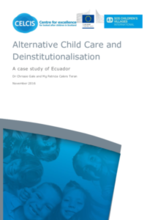Introduction
The European Commission Directorate-General for International Cooperation and Development (DG DEVCO) commissioned SOS Children’s Villages International to undertake case studies of arrangements for ‘alternative child care’ in six non-European countries across three continents to help inform the EU’s future strategy for provision of support for children in countries outside Europe. This report is a case study of one of the six countries, Ecuador. A companion report provides a summary of alternative child care across Central and South America. The results of the regional reports and case studies are synthesised in a report entitled Towards the Right Care for Children: Orientations for reforming alternative care systems – Africa, Asia, Latin America (European Union, Brussels, 2017).
Methodology
The methodology employed for this study included a literature review undertaken through a key word search in the database Web of Science and other web-based search engines. Literature was also supplied by contacts in Chile. One international consultant conducted interviews with key informants and one national staff member of SOS Children’s Villages conducted interviews with children and young people.
The socio-economic and cultural context
Ecuador is classified by the World Bank as being in the upper middle income group. In 2016 the population of Ecuador was an estimated 16,080,776 inhabitants. Life expectancy at birth is 73.8 years for males and 79.9 years for females.
Almost half the population lives in the interior of the country in the Andean intermountain basins and valleys, with large concentrations also found along the western coastal strip. Areas of rainforests of the east remain sparsely populated. In 2015 it was estimated that 63.7% of total population lived in urban conurbations.
Results of the 2010 Population and Housing Census showed 7% of the population to be indigenous, 7.2% Afro-Ecuadorian, 7.4 % Montubian, 6.1 % white, 71.9 % mestizo and 0.4 % ‘other’. In 2010, approximately 10% of children under the age of 5 years were not registered at birth. This increases to 30% with the Afro-Ecuadorian population.
Why children are placed in formal alternative care
Children are placed in alternative care as a measure of protection from all forms of abuse, exploitation and neglect. Overwhelmingly it is claimed that poverty is no longer the driving factor, although this often remains an underlying concern. Children can be removed from parental care through a judicial or an administrative order when there are concerns of abuse and neglect.
Types of alternative care available
The most common form of care is informal care within the extended family. This is mostly undocumented and unregulated. Lack of available data means it is has not been possible to identify the benefits and challenges of this form of care in Ecuador.
The are no other formal alternative care arrangements in Ecuador other than the use of residential facilities. Residential facilities are operated by Government and non-state providers. Residential facilities vary in size and the quality of care they offer. In 2015, a total of 2,520 children were living in residential facilities in Ecuador, falling from 4,111 in 2012. The latest population data in 2010 states those aged 0-17 years totalled 5,567,700, this indicates approximately 0.045% of the total child population in Ecuador are children living in residential care.
A pilot foster care programme initiated by a non-state service provider with the agreement of the Ministry of Economic and Social Inclusion (MIES) was suspended by the Ministry in January this year. During the pilot only a small number of children had been placed in care through the programme. For exmple, two NGOs indicated they had approximately 9 children in total either placed, or in the process of going, into foster care. However, it was also believed this pilot has already provided ‘a richness of information and experience.
Although the Government of Ecuador has various programmes and policies related to delivery of services for children and families, key informants in this study were unanimous in their view that specially targeted interventions to prevent family separation are weak and under-resourced. In addition, a major concern is recent changes to legislation that detract from the specificity of child protection to one that integrates this concern into a broader inter-generational approach to addressing the most vulnerable in society.
The Code for Children and Adolescents (CONA) along with other policy and statutory regulations endorse Government requirement to support reunification of children from formal care back with parents or extended family when and as soon as possible. In 2014, of a total of 2,585 children in residential care, 796 returned to their families endorsed by a legal measure approving family reintegration. In 2015, this figure rose to 1,098 children. Once again this study has found that programmes of reintegration are not being systematically applied by service providers.
Young people are expected to leave their placement in alternative care when they reach their eighteenth birthday. There is no Government social protection or other schemes that assist with this process. In addition although some non-state providers are doing very little for care leavers, others are specifically raising funds and developing support programmes.
Data obtained from an unpublished Government of Ecuador report of May 2016 shows the number of national adoptions administered by the National Office of Adoptions in 2015 totalled 136, with 514 post-adoption cases being followed up.

